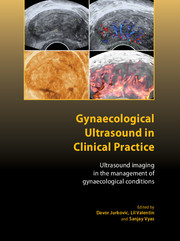 Gynaecological Ultrasound in Clinical Practice
Gynaecological Ultrasound in Clinical Practice Book contents
- Frontmatter
- Contents
- About the authors
- Abbreviations
- Preface
- 1 Ultrasound imaging in gynaecological practice
- 2 Normal pelvic anatomy
- 3 The uterus
- 4 Postmenopausal bleeding: presentation and investigation
- 5 HRT, contraceptives and other drugs affecting the endometrium
- 6 Diagnosis and management of adnexal masses
- 7 Ultrasound assessment of women with pelvic pain
- 8 Ultrasound of non-gynaecological pelvic lesions
- 9 Ultrasound imaging in reproductive medicine
- 10 Ultrasound imaging of the lower urinary tract and uterovaginal prolapse
- 11 Ultrasound and diagnosis of obstetric anal sphincter injuries
- 12 Organisation of the early pregnancy unit
- 13 Sonoembryology: ultrasound examination of early pregnancy
- 14 Diagnosis and management of miscarriage
- 15 Tubal ectopic pregnancy
- 16 Non-tubal ectopic pregnancies
- 17 Ovarian cysts in pregnancy
- Index
16 - Non-tubal ectopic pregnancies
Published online by Cambridge University Press: 05 February 2014
- Frontmatter
- Contents
- About the authors
- Abbreviations
- Preface
- 1 Ultrasound imaging in gynaecological practice
- 2 Normal pelvic anatomy
- 3 The uterus
- 4 Postmenopausal bleeding: presentation and investigation
- 5 HRT, contraceptives and other drugs affecting the endometrium
- 6 Diagnosis and management of adnexal masses
- 7 Ultrasound assessment of women with pelvic pain
- 8 Ultrasound of non-gynaecological pelvic lesions
- 9 Ultrasound imaging in reproductive medicine
- 10 Ultrasound imaging of the lower urinary tract and uterovaginal prolapse
- 11 Ultrasound and diagnosis of obstetric anal sphincter injuries
- 12 Organisation of the early pregnancy unit
- 13 Sonoembryology: ultrasound examination of early pregnancy
- 14 Diagnosis and management of miscarriage
- 15 Tubal ectopic pregnancy
- 16 Non-tubal ectopic pregnancies
- 17 Ovarian cysts in pregnancy
- Index
Summary
Introduction
Ectopic pregnancy is a significant health problem in the developed world, which affects 1–2% of women of reproductive age, causing significant morbidity and mortality. Most ectopic pregnancies are located in the ampullary, fimbrial or isthmic parts of the fallopian tube. However, approximately 7% of ectopic pregnancies are not located within these parts of the tube and they are classified as non-tubal ectopics. Each of these rare forms of ectopic pregnancies often represents a diagnostic and therapeutic challenge because of their atypical location and paucity of experience in their management.
In this chapter, we will provide a summary of each type of non-tubal ectopic pregnancy, with particular emphasis on the ultrasound diagnosis and management options.
Interstitial pregnancy
Interstitial pregnancy is characterised by the implantation of the conceptus in the interstitial portion of the fallopian tube, which is surrounded by the muscular wall of the uterus. Interstitial pregnancy is sometimes referred to as cornual pregnancy. However, the term cornual pregnancy is more appropriately used to describe implantation of pregnancy in the rudimentary or atretic cornu of a congenitally abnormal uterus.
Incidence and predisposing factors
Interstitial pregnancy rates are increasing steadily, mirroring the increase in ectopic pregnancy rates. Interstitial pregnancy complicates between 2% and 6% of all ectopic pregnancies or 1 in 2500–5000 live births. Risk factors predisposing to an interstitial pregnancy include previous tubal ectopic pregnancy, previous ipsilateral salpingectomy, assisted reproductive technology and sexually transmitted infections.
Keywords
- Type
- Chapter
- Information
- Gynaecological Ultrasound in Clinical PracticeUltrasound Imaging in the Management of Gynaecological Conditions, pp. 193 - 210Publisher: Cambridge University PressPrint publication year: 2009
